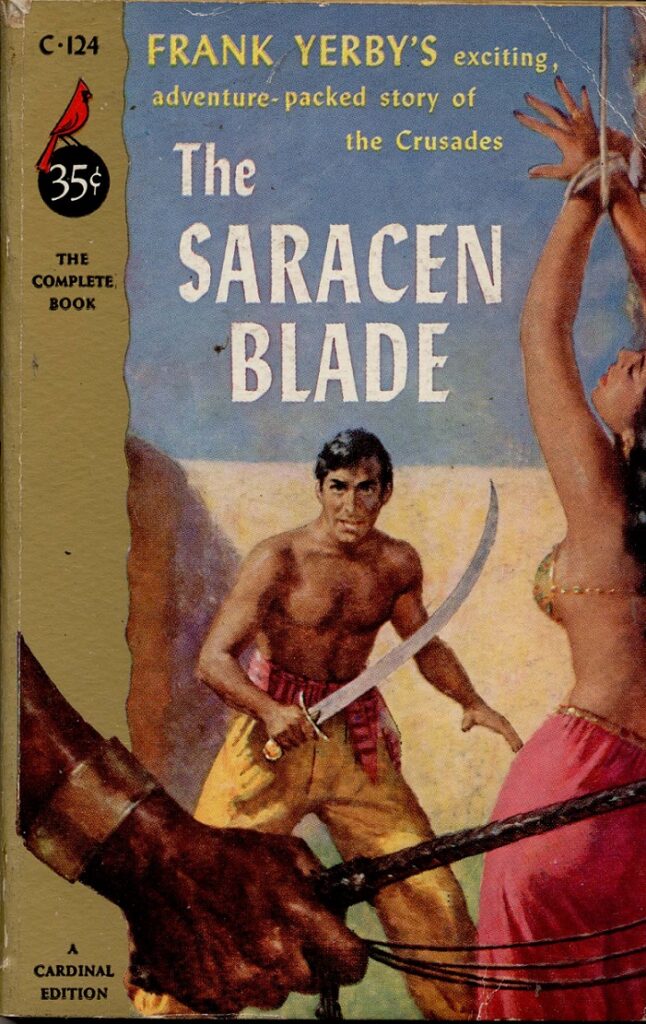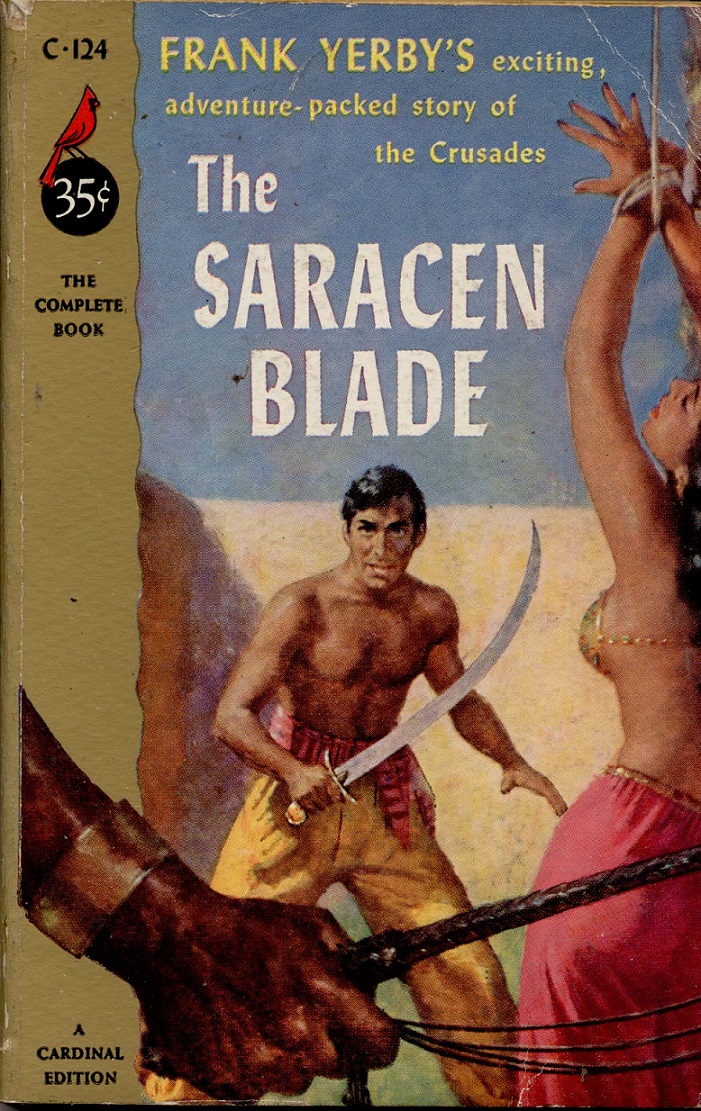Book Review: The Saracen Blade by Frank Yerby
The Holy Roman Emperor Frederick II was born in Jesi, Italy in 1194. But another child was born on that day in that place. Pietro, son of Donati the armorer and his lovely wife Maria, was delivered by one of the same midwives as she’d gone into labor just as the Empress was delivered of her son in the public square. Sadly, Maria died of childbed fever a few days later. The two men were perhaps entwined by fate.

Donati was at the time an employee of Isaac the Jew, a wealthy merchant. But the feudal lord of the area demanded that Donati serve him in his need for armor as he disputed with neighbors and Isaac had to allow this, so became Pietro’s foster father from a young age. With no son of his own, Isaac had Pietro educated in not just Catholic lore, but that of the Jewish scholars and Saracens who lived in Sicily.
In his early teens, after meeting and bonding with the young Frederick, Pietro learns that his father is leading a peasant rebellion against the cruel head of the Siniscola family, the very noble who’d drafted him. He briefly reconnects with Donati but is unable to get him to escape before the Count’s forces overwhelm the town. Donati and Isaac (who’d hoped to bribe the Count into mercy) are tortured to death and Pietro is forced to take refuge with a friend of Isaac’s.
While there, he runs into the children of Baron Rogliano, the youngest, Iolanthe, takes a shine to him. He becomes squire to her brother Hans, and falls in love with Iolanthe. Bad news–her father wants her to marry Enzio Siniscola, one of the sons of Count Siniscola. The baseborn Pietro is not even in the running. His friendship with Frederick is not a help, as the boy king is essentially out of office.
Things come to a head, and Iolanthe comes up with a plan for them to elope. Foolishly, she decides they’ve gone far enough for a consummation break. Her brothers show up, give Pietro a beating, and carry Iolanthe off to her wedding. Pietro is saved from death by a passing French knight, Gautier. The two young men bond, and Pietro becomes Gautier’s squire.
As it happens, Gautier is in Sicily to convey a message from the French king, who supports Frederick in his bid for the Holy Roman Empire’s throne. That message delivered, the men head back to France.
In France, Gautier and his squire are pressed into service against the Albigensian heretics, who include Gautier’s uncle and possibly his sister. It’s more butchery than a war, and Pietro is sickened by it. After the death of the uncle, it’s discovered that Gautier’s sister Antoinette wasn’t there, but had run off to join the Children’s Crusade.
By the time they find her, Toinette has been sold to a brothel, where she’s been ill-used and is with child. She’s suicidal and this would normally be a great scandal for the family, but Pietro volunteers to marry Gautier’s sister so they can fudge the dates and make the child look legitimate.
At this point, the French king needs assistance with his own battle against the English, which is a “cleaner” fight than against the pacifistic heretics. Pietro saves the king’s life and is knighted at last.
Unfortunately, Antoinette never recovered from her trauma and their marriage is quietly annulled so she can become a nun. Pietro goes to Germany, as Frederick has now become Emperor. He’s knighted again, and sent to Sicily to act as the Emperor’s representative until Frederick can get back there to arrange things, including finally releasing Pietro’s large inheritance from Isaac.
Pietro checks in with the astoundingly beautiful but ill-tempered Elaine, who married the only decent member of the Siniscola family, only to have that man promptly die during the visit.
He then has an assignation with Iolanthe, which promptly gets discovered by Enzio. The angry husband imprisons Pietro, but then has to do feudal obligation stuff for a couple of months, allowing Pietro and Iolanthe to get it on in the dungeon. When Enzio returns, he will spare Io’s life if she stops using birth control, but is going to execute Pietro, so that person has to make a daring escape.
A couple of years later, Iolanthe has given birth to a child, (spoiler: it’s actually Pietro’s) so Pietro is trying to move on when Frederick finally shows up in Sicily again. He needs Pietro to help him subjugate the rebellious lords, and our protagonist primarily concentrates on the Siniscolas. Enzio is forced out of his castle but spared (and given a house for himself and his immediate family) while all but one of the remaining male Siniscolas are defeated and slain by Pietro in chivalric combat. He rubs it in by being especially gracious in victory.
Frederick wants Pietro to get married and have sons, and basically orders him to wed Elaine. Despite her many grievances against Pietro, he’s almost won Elaine when she learns this isn’t a voluntary arrangement. She marries Pietro, but swings wildly between anger at him and being hot for his body.
Needing a break from this relationship, Pietro volunteers to join the Sixth Crusade that Emperor Frederick is supposed to be a part of. As so often with the Crusades, the people leading it have lost the plot and are currently trying to conquer Cairo. Pietro and the other knights can see this is a doomed expedition, but the bishop in charge is convinced God will send a few miracles to make it work.
It doesn’t, but Pietro, who you will recall was trained by Saracen scholars, saves himself by feigning a conversion to Islam. He’s still enslaved, but in a superior managerial position. Also picked up by Shaikh al-Muqtafi is the beautiful but headstrong slave girl Zenobia, who he marries immediately to spite the Caliph. This leads to a scene similar to the one on the cover, where Pietro saves Zenobia from being whipped to death for refusing the Shaikh’s loathsome son.
A few years later, the Shaikh is pressured into using Pietro as a brainwashed assassin (as in the people we get the word from) to take out Emperor Frederick, who has finally arrived in the Holy Land, and the Caliph. Pietro cleverly avoids being actually brainwashed, and winds up saving Frederick’s life again.
Back in Sicily, it turns out Elaine’s been having an affair with Andrea Siniscola, one of the two remaining Siniscola brothers. Given he wasn’t exactly faithful while in Egypt, Pietro forgives her easily and the two reconcile. For a while. Until he learns that she never actually stopped boinking Andrea. In the ensuing mess, both Andrea and Elaine die.
Pietro throws himself into his work supporting the Emperor for another few years, until he learns that Enzio attacked his home, razing it, killing a bunch of his servants, and kidnapping Zenobia. This leads to a final battle. Zenobia takes her own life to avoid being raped, and Enzio is killed by his own abused peasants. Pietro and Iolanthe are finally able to be together, along with their son (who’s known the truth for years.)
That is a *lot* of novel. The author, Frank Yerby, was mixed-race but identified as African-American. He’d started his career doing “protest” novels (what conservatives would now call “woke”) but was unable to interest major publishers in the 1940s. He switched to romance novels, and then historical adventure, which turned out to be very popular. He was the first African-American author to have a million copies sold of one of his novels! Three of his books were turned into movies, including this one. It starred Ricardo Montalban and as of this writing can be found on Youtube.
The writing style is a mix of pulpish action, stream of consciousness (words like “greenfire” and “musclemeat” show up from time to time) and erudite research. Mr. Yerby was big on historical research, and although some of his sources might be outdated now, the footnotes section is a nice bonus.
Pietro is an interesting protagonist. He is a good mix of underdog and advantages, so his few victories seem earned. He suffers a bit from the common historical novel protagonist syndrome of having 20th Century attitudes in a 13th Century setting. For example, he appreciates Frederick doing a lot to shake up the rigid feudal caste system, but thinks that ideally, a democratic republic would be a better plan. He’s also a freethinker, since he’s studied the religious beliefs of the three major Abrahamic religions and is dubious about all of them. (He’s still culturally Catholic and avoids mentioning theological musings out loud.)
Morally, he’s a mixed bag. Pietro understands the concept of sexual consent, so never forces himself on the sex-averse Antoinette, even though as her legal husband he would have the right to. On the other hand, when he finds out the woman he’s cheating on Antoinette with is also cheating with other men, Pietro gets all kinds of offended. He maintains the double standard about infidelity.
When it comes to killing, Pietro would rather not. He’s okay with it in combat, because that’s war, but he’s not down with murder, and especially not torture. Except when it’s Andrea Siniscola, but he swiftly repents too late.
Slavery is considered normal for the societies of this era. Pietro has slaves assigned to him at various points, though he never buys any, and he doesn’t see a problem with being enslaved himself outside the need to escape that state.
I also appreciated that for once, the word “swarthy” did not mean the person so described was a villain.
Content note: War, murder, suicide. Torture and public execution. A woman has acid thrown in her face, permanently scarring her. Rape (always off-page), infidelity. Religious prejudice. Classism. Slavery. Use of outdated terms. Late teens on up should be able to handle it.
This novel is “of its time” and is sometimes thick going for a modern reader, but has many good bits and solid historical detail. It’s been out of print since the 1970s, but you should be able to locate a copy in finer used book stores. Most recommended to men’s adventure fans and people who enjoy historical romance.

